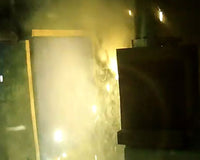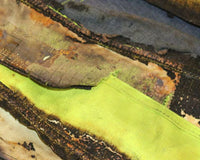Whether it’s from dust, arc flash, or impact, protecting your eyes is critical. EN 166 is a European standard that specifies the requirements for personal eye protection. This standard covers various types of eye protection including safety glasses, goggles, face shields, and visors.
The EN 166 standard
EN 166 is a European standard that specifies the core requirements for personal eye protection across the construction, design, and performance. The EN 166 standard applies to any protective eyewear that isn’t already covered by its own specialised standard. The latest version of this standard is EN 166:2002, ensuring protection in line with PPE (EU) regulation 2016/425.
This standard specifies testing methods and basic requirements for protective eyewear including safety glasses, goggles, and visors. EN 166 compliant personal eye protection is commonly used in environments where the wearer may be exposed to a variety of risks, such as liquid splashes, dust particles, and light filtration.
EN 167:2001 and EN 168:2001 considerations for eyewear testing
EN 167:2001 and EN 168:2001 are supplementary European standards to EN 166. These supplementary standards specify the optical and non-optical criteria against which EN 166 certified protective eyewear must be tested.
Optical tests for EN 167
The EN 166 standard requires the optical assessment of eyewear lens or face shield to be tested under EN 167.
EN 167 optical tests are conducted to ensure the personal eye protection does not impede or distort the wearer’s vision, while still allowing sufficient light through to the wearer’s eye. The EN 167 optical assessment includes tests for field of vision, transmission and diffusion, and refractive properties.
The field of vision test ensures that the wearer’s vision is not impacted by the frame or the periphery of the lenses. The transmission and diffusion tests measure UV light exposure and resistance. The refractive assessment measures spherical, astigmatic, and refractive powers.
Non-optical tests for EN 168
The EN 166 standard also requires non-optical assessments to be carried out under EN 168. These non-optical tests measure the robustness of the protective eyewear through two tests for minimum robustness and increased robustness.
The minimum robustness test places a static load of 10kg on the centre of the ocular (lens). During this test, the ocular must not sustain any damage that results in cracking through the entire thickness or cracking into two or more pieces. Fragments of 5mg or more must not become detached from the lens. The minimum robustness test is only applicable to cover plates or filtering oculars.
The increased robustness test should only be performed on complete eye protectors. This test is conducted by dropping a steel ball, with a 43 g minimum mass, onto the visual centre of the protective eyewear. The height from which the steel ball is dropped provides an approximate impact speed of 5.1 m/s. For unmounted oculars covering one eye or in which the visual centre cannot be established, the geometric centre will be used.
The increased robustness test is carried out under two temperature conditions, with new oculars being used for each impact test and temperature condition.
EN 166 specifications for optical class and mechanical strength
EN 166 categorises protective eyewear based on its specified optical class and mechanical strength.
The optical class details the different types of protective eyewear based on its intended period of usage.
The mechanical strength rating is used to determine how much impact the glasses can withstand, allowing the wearer to choose suitable personal eye protection based on the environment in which it is intended to be worn.
Optical class
There are three levels of optical class that can be applied to EN 166 certified protective eyewear. These levels are used to determine how often the glasses should be worn. The optical class only refers to the eyewear lens, not the frame.
|
Optical class |
Usage standard |
Frame |
Lens |
|
Class 1 |
Permanent wear (distortion free) for continuous work |
- |
1 |
|
Class 2 |
Occasional wear for intermittent work |
- |
2 |
|
Class 3 |
Brief wear for occasional work (must not be worn continuously) |
- |
3 |
Mechanical strength
The mechanical strength rating of protective eyewear is displayed by a letter. This strength rating categorises eyewear based on impact resistance, as per the non-optical assessment.
|
Strength rating |
Mechanical strength requirement |
Frame |
Lens |
|
- |
Minimum robustness |
- |
- |
|
S |
Increased robustness |
S |
S |
|
F |
Low energy impact (impact speed of 45 m/s) |
F |
F |
|
B |
Medium energy impact (impact speed of 120 m/s) |
B |
B |
|
A |
High energy impact (impact speed of 190 m/s) |
A |
A |
For eyewear that meets the requirements of minimum robustness, there will not be a symbol on the eyewear marking.
Protective eyewear that can withstand the increased robustness test will be marked with an S symbol.
Symbols F, B, or A are given to protective eyewear that offer low, medium, or high energy impact resistance. The F, B, or A strength ratings are only applicable to certain types of eye protectors. Low energy impact resistance is the highest level of impact that protective glasses or spectacles can provide. Medium energy impact resistance can apply to goggles, visors, or face shields. If high energy impact resistance is required, only face shields can be used.
|
Strength rating |
Mechanical strength requirement |
Type of protective eyewear |
||
|
Spectacles / Glasses |
Goggles |
Face shields / Visors |
||
|
- |
Minimum robustness |
|||
|
S |
Increased robustness |
|||
|
F |
Low energy impact (impact speed of 45 m/s) |
✓ |
✓ |
✓ |
|
B |
Medium energy impact (impact speed of 120 m/s) |
× |
✓ |
✓ |
|
A |
High energy impact (impact speed of 190 m/s) |
× |
× |
✓ |
Optional specifications for risks and treatments
The eyewear marking for EN 166 certified personal eye protection may also include a series of letters or numbers to denote optional specifications for risks and treatments. As these specifications are optional, they will only appear if they are relevant.
These optional specifications may also not be suitable for all types of eyewear. The only valid tests for spectacles are those with a K, N, or R symbol. Spectacles cannot be tested for any risks that they cannot reasonably protect against, such as dust particles or liquid splashes.
The risks and treatments covered by these optional specifications are chemical risk, electrical risk, thermal risk, and lens treatments.
Chemical risks
EN 166 certified protective eyewear that offer protection against chemical risks may be marked with a number 3, 4, or 5 depending on the level of protection provided. This optional specification is only applicable to relevant goggles and face shields/visors.
|
Chemical risk rating |
Chemical risk requirement |
Frame |
Lens |
|
3 |
Liquid splash protection |
3 |
- |
|
3 |
Liquid droplet protection |
3 |
- |
|
4 |
Resistance to large dust particles over 5 microns |
4 |
- |
|
5 |
Resistance to gases and dust particles under 5 microns |
5 |
- |
Electrical risks
EN 166 certified personal eye protection that is able to withstand an electrical risk of a short circuit arc may be marked with a number 8. This optional specification is only applicable to relevant visors or face shields.
|
Electrical risk rating |
Electrical risk requirement |
Frame |
Lens |
|
8 |
Resistance to short circuit arcs |
8 |
- |
Thermal risks
EN 166 certified eyewear that offers protection against thermal risks may be marked with a number 9. This optional certification is relevant for those working in an environment where there is a risk of molten metal splashes and hot solids projection. A thermal risk rating is only applicable to relevant goggles and face shields/visors.
|
Thermal risk rating |
Thermal risk requirement |
Frame |
Lens |
|
9 |
Resistance to molten metal splashes and hot solids projection |
9 |
9 |
Lens treatments
EN 166 certified eyewear that has been designed with particular lens treatments such as anti-scratch or anti-fog capabilities may be marked with a corresponding letter. This lens treatment specification is suitable for relevant spectacles/glasses, goggles, and face shields/visors.
|
Lens treatment rating |
Lens treatment requirement |
Frame |
Lens |
|
N |
Resistance to fogging (anti-fog) |
- |
N |
|
K |
Resistance to surface damage by small particles (anti-scratch) |
- |
K |
Related eyewear safety standards
As mentioned, the EN 166 standard covers the core requirements for personal eye protection. As well as EN 166, there are other eyewear related safety standards pertaining to more specialist uses, environments, and requirements.
Other relevant standard for personal eye protection include:
- EN ISO 4007:2018: Personal protective equipment - Eye and face protection - Vocabulary
- EN 170:2002: Personal eye protection - Ultraviolet filters - Transmittance requirements and recommended use
- EN 171:2002: Personal eye protection - Infrared filters - Transmittance requirements and recommended use
- EN 172:1995: Personal eye protection - Sunglare filters for industrial use
- EN 175:1997: Personal protective equipment - Equipment for eye and face protection during welding and allied processes
- EN 379:2003+A1:2009: Personal eye protection - Automatic welding filters
- EN 1731:2006: Personal eye protection - Mesh eye and face protectors
How to choose protective eyewear
When choosing protective eyewear, be sure to consider the application of use and the risks you may be exposed during usage. Choose the personal eye protection that is most suitable for your needs by checking the EN 166 markings to determine what requirements the eyewear has been tested against.
EN 166 compliant eyewear has been tested in accordance with European standards, ensuring the eyewear offers basic testing requirements. For tasks with increased exposure to risk or more specialist use cases, you may need to choose eyewear that complies with more specific standards.

























